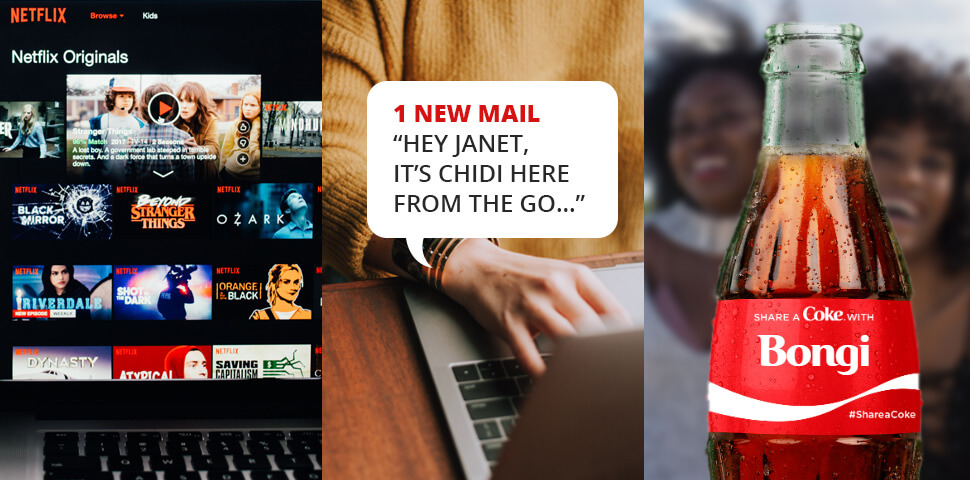You know when an email lands in your inbox, and your name’s in the subject line? Or when you can’t decide on what to watch on Netflix, but a thumbnail catches your eye – and five minutes in, you’re hooked?
That’s marketing personalisation.
Marketing personalisation is what happens when products or services are targeted to customers based on data that’s been collected about them. The more data you have, the more personalised your marketing messaging can be – and the more sales you’ll get.
According to a recent Infosys Rethinking Retail study, 86% of the respondents said that personalisation influences what they buy to some extent, while a quarter said that personalisation significantly influences what they buy.
“Significantly influences” is quite a statement: if your marketing is effectively personalised it can make the difference between whether someone buys your product (or invests in your service), or not.
For marketing personalisation to work, you need to
S E G M E N T your audience
Marketing personalisation goes beyond first names in email subject lines (although personalising email subject lines can increase open rates by 50%, so don’t knock it until you try it). Effective personal marketing messaging builds relationships with your potential customers, cements loyalty, and closes those sales.
A potential lead, who feels like they’re not just a sale-in-the-making, is a customer who’ll convert. Trust us.
But it’s not easy to pull off. In order to start building those relationships (and closing those sales) you need to target your messaging based on specific data relating to your customers’ digital presence.
Depending on your objectives, this data can cover everything from what city they live in (geo-location) to if they’re an extroverted vegan (psychographics). This data, in turn, will shape how your marketing messaging is tailored – and how effective its uptake will be.
If a potential customer feels like your business really understands them – and that they’re seen as individuals with unique concerns and needs – you’re winning.
This is where segmentation comes in – stay with us, because it’s really important.
A segment is when a part of your audience (or it can even be an individual) is given certain ‘attributes’, to use marketing speak. These attributes can be anything from their geo-location to their demographics. For a hyper-personalised experience, you can go really deep with this data and even look at their behaviour, their lifestyle, and how they feel about things (read more about targeting behaviour and psychographics in this article).

The data that’s collected will inform the level of personalisation (data collection involves things like CRMs, integrated databases and machine learning; if that makes your head spin, we know about that stuff and can help you).
If you’re not using the right tools to track data – whether it’s what your potential customers do online or what their job title is – you’re at a huge disadvantage (even more so in this train wreck of a year called 2020).
Say that some of your potential customers can be found in the banking industry. You need to segment that audience according to their industry, then direct them to tailor-made content that will resonate strongly with people in the banking sector – ideally it would need to speak to specific problems that they face, and offer them solutions.
You can do this by setting up an emailer with a personalised, highly relevant subject line, and in the body of the email you direct them to a link. The link goes to a tailor-made landing page with content that speaks to the banking industry, and a call-to-action that the visitor can’t ignore (remember, their journey has been personalised – based on their segment – from the start).
Get personal – but don’t be creepy
Marketing personalisation can tread a fine line between creepy and curated: it needs to be done in a way that isn’t invasive. You can still target personalised messaging to potential clients without crossing privacy boundaries, however.
Say you’re like us, and you run a digital marketing agency. You can personalise your next emailer by putting a group of your clients (from the same brand) into an email segment, then targeting an email blast just to that segment and including an image of their brand’s logo with a message like: “Hey Brand X! We loved building your website and we hope you’re rocking the disaster that is 2020.”
This in itself will make Brand X think you’re amazing, it’ll foster loyalty, and it means you can upsell with a website maintenance package…

Two examples of personalisation done right (and one that went pear-shaped)
Netflix
Netflix really knows what they’re doing when it comes to personalisation. Its algorithm shows users highly tailored recommendations based on viewing history, and series and film-cover art is personalised based on interactions with the streaming service.
Netflix uses infinitesimal amounts of user data to personalise the app’s user experience. Using the Watchlist feature, they run 250 A/B tests per year, they know when you hit pause, if you stop watching after five minutes, and what you add to (or remove from) your list. Which is why no user is shown the same combination of rows on the Netflix homepage – and one of the reasons why they have 193 million paid subscriptions worldwide.
Their personalisation isn’t just based on the selection of titles: they optimise series and film-cover art based on user interactions (if you tend to watch films with a particular actress, for example, then the imagery will highlight that actress). This personalisation strategy gets users to watch things that they wouldn’t normally watch. It’s creepy, and very clever.
A client of ours
This is something we pulled off for a client of ours (and we’re quite proud of ourselves). Hold our collective beers…
We embarked on a lead-generation campaign for a company that deals in office supplies. They have various branches, but each branch has its own account manager and account director, so we looked at the data (specifically their customer email lists) to target individual branches in a hyper-local and personal way.
We received a list of 1 000 people from one of their branches – we then segmented that data based on geo-location. We sent out an email campaign to 10 000 people, but for the segmented email addresses, we made the mass email appear that it came from a particular branch’s account manager (the segment was based on that branch’s area).
Each branch also has its own logo, so we set up the segmented mailers with different URLs that corresponded to specific branch websites (and their logos). People who weren’t in the specific area segment were shown the generic, main site, but if they were part of the segment they were sent to the relevant branch’s campaign. The result was a hyper-local and personal experience, which meant more leads for the supplier…
Share a Coke (or, don’t)
This global campaign, where Coca-Cola replaced its logo on its cans with the words “Share a Coke with” followed by someone’s name, started off really well (in 2014 in the U.S., the brand saw a 2% increase in sales, as well as #shareacoke becoming the number-one trending hashtag on social media).
Coca-Cola’s entire campaign was based on the most basic principle of personalisation: using someone’s name. At our core, humans are pretty basic, too: being addressed by our names makes us feel special and recognised as an individual.
Then in 2019, something rather unfortunate happened (and it reminds of us of the #deeppanalbumparty hashtag hash-up). In the consumer-led South African version of the campaign, a profanity in Tsonga was printed on a bunch of cans, and the Tsonga community was unimpressed. The campaign was cancelled – and goes to show that ‘getting personal’ can take on a whole, new meaning…
If you’re rusty on your Tsonga and really want to know what xitombo means, read this article.

Firewater’s top three tips to get personal
- Always know what your aim is. Do you want more repeat website visitors? More leads? More trust in your brand? More sales? Be clear on your objective from the get-go, otherwise you’ll get lost along the way.
- Use email. It’s an easy starting point towards personalisation – but make sure you sound like an actual human being because people catch on very fast to mailers that are from robots. Any easy win is to replace your company email as the sender name with the name of a person who works on your team (like the sales manager, for example). Not good with ‘the words’? We have most excellent copywriters who can craft personalised mailers.
- Create a marketing persona, and content to match. A persona is basically a version of your ideal customer, based on their likes, demographics, how they feel about the world, their unique problems that need to be solved, and a whole lot more. A persona is a lot like a segment. It’s therefore important to create content that’s targeted to your persona, so that it speaks to them on a personal and direct level (read more about what an effective content marketing strategy entails here).
Bonus point: Respond to customers personally on social media. Don’t use automated software when replying to comments or inbox messages; use an individual profile instead.
Marketing personalisation is tricky: sometimes you can have terabytes of data but it’s not specific enough (you only have surnames, or you know someone is in finance, but that could be banking or insurance or debt-collection). Or, part of your marketing is personalised, but the target in question is led to a generic landing page.
That’s why you have to know exactly who your audience is, what segment they’re in, and what will resonate with them.
Marketing personalisation lets your potential customers feel seen and understood – which is what everyone wants, really. It also tells them that your business cares about them, which converts leads into actual customers – and that’s what all businesses want.
The rest of this year doesn’t have to be a write-off: when you target your products or services in a personal way, magical things happen to your bottom-line.
Want your business to thrive, even in this mess of a year? You need a results-driven, personalised digital marketing strategy. Contact us – what we do, we do well.




